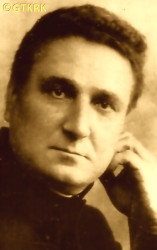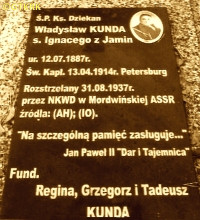Roman Catholic
St Sigismund parish
05-507 Słomczyn
85 Wiślana Str.
Konstancin deanery
Warsaw archdiocese, Poland
full list:
displayClick to display full list

searchClick to search full list by categories
wyświetlKliknij by wyświetlić pełną listę po polsku

szukajKliknij by przeszukać listę wg kategorii po polsku

Martyrology of the clergy — Poland
XX century (1914 – 1989)
personal data
surname
KUNDA
forename(s)
Vladislav (pl. Władysław)
function
diocesan priest
creed
Latin (Roman Catholic) Church RCmore on
en.wikipedia.org
[access: 2014.09.21]
diocese / province
Mogilev archdiocesemore on
en.wikipedia.org
[access: 2013.06.23]
date and place
of death
31.08.1937

ITL TemLagGuLAG slave labour camp network
today: Mordovia rep., Russia
more on
en.wikipedia.org
[access: 2022.01.09]
details of death
For the first time arrested by the Russians on 05.12.1935 in Rahachow in Belarus.
Accused of membership of „nationalistic group of Poles–Catholics”.
On 20.05.1936 sentenced to 8 years of slave labour in Russian concentration camps.
Sent to ITL TemLag (Mordova rep.) concentration camp.
There, in the camp, arrested in 1937 again.
Accused of „systematic counter–revolutionary and anti–Russian activities among camp's prisoners”.
On 22.08.1937 sentenced by the Russian genocidal Special Council NKVD kangaroo court (known as «NKVD Troika») to death and executed.
cause of death
murder
perpetrators
Russians
sites and events
11.08.1937 Russian genocideClick to display the description, Great Purge 1937Click to display the description, ITL TemLagClick to display the description, GulagClick to display the description
date and place
of birth
12.07.1887

Jaminytoday: Sztabin gm., Augustów pov., Podlaskie voiv., Poland
more on
en.wikipedia.org
[access: 2022.01.28]
alt. dates and places
of birth
13.04.1887
presbyter (holy orders)
ordination
13.04.1914

Sankt Petersburgtoday: Saint Petersburg city, Russia
more on
en.wikipedia.org
[access: 2020.07.31]
Dormition of the Blessed Virgin Mary RC cathedral churchmore on
en.wikipedia.org
[access: 2020.11.01]
positions held
c. 1930 – 1935
parish priest — Rahachowtoday: Rahachow dist., Gomel reg., Belarus
more on
en.wikipedia.org
[access: 2020.11.27] ⋄ Immaculate Conception of the Blessed Virgin Mary RC parish ⋄ Rahachow / Bykhawdeanery names/seats
today: Belarus RC deanery
rector — Gomeltoday: Gomel dist., Gomel reg., Belarus
more on
en.wikipedia.org
[access: 2021.09.17] ⋄ Assumption of the Blessed Virgin Mary RC church ⋄ Gomeltoday: Gomel dist., Gomel reg., Belarus
more on
en.wikipedia.org
[access: 2021.09.17] RC deanery
1924 – c. 1930
administrator — Samaratoday: Samara oblast, Russia
more on
en.wikipedia.org
[access: 2022.04.12] ⋄ Sacred Heart of Jesus RC parish ⋄ Samaratoday: Samara oblast, Russia
more on
en.wikipedia.org
[access: 2022.04.12] RC deanery — chaplain of the Siberian chapels in Orenburg, Hoffental and Reinsfeld
from 1922
administrator — Święciłowiczetoday: Lebedyanka ssov., Byalynichy dist., Mogilev reg., Belarus
more on
be.wikipedia.org
[access: 2022.06.29] ⋄ St Louis the King and Confessor RC parish ⋄ Mohylew / Horkideanery names/seats
today: Mogilev reg., Belarus RC deanery
vicar — Tobolsktoday: Tobolsk city reg., Tyumen oblast, Russia
more on
en.wikipedia.org
[access: 2022.07.16] ⋄ Holy Trinity RC parish ⋄ Omsktoday: Omsk oblast, Russia
more on
en.wikipedia.org
[access: 2022.08.05] RC deanery
1915 – 1917
vicar — Omsktoday: Omsk oblast, Russia
more on
en.wikipedia.org
[access: 2022.08.05] ⋄ Immaculate Conception of the Blessed Virgin Mary RC parish ⋄ Omsktoday: Omsk oblast, Russia
more on
en.wikipedia.org
[access: 2022.08.05] RC deanery
1914 – 1915
vicar — Veliky Novgorodtoday: Novgorod oblast, Russia
more on
en.wikipedia.org
[access: 2022.04.17] ⋄ St Peter and St Paul the Apostles RC parish ⋄ Sankt Petersburg Extra Urbemdeanery name
today: Saint Petersburg city, Russia
more on
en.wikipedia.org
[access: 2020.07.31] RC deanery
till 1914
student — Sankt Petersburgtoday: Saint Petersburg city, Russia
more on
en.wikipedia.org
[access: 2020.07.31] ⋄ philosophy and theology, Metropolitan Theological Seminary
sites and events
descriptions
11.08.1937 Russian genocide: On 11.08.1937 Russian leader Stalin decided and NKVD head, Nicholas Jeżow, signed a «Polish operation» executive order no 00485. 139,835 Poles living in Russia were thus sentenced summarily to death. According to the records of the „Memorial” International Association for Historical, Educational, Charitable and Defense of Human Rights (Rus. Международное историко‐просветительское, правозащитное и благотворительное общество „Мемориал”), specialising with historical research and promoting knowledge about the victims of Russian repressions — 111,091 were murdered. 28,744 were sentenced to deportation to concentration camps in Gulag. Altogether however more than 100,000 Poles were deported, mainly to Kazakhstan, Siberia, Kharkov and Dniepropetrovsk. According to some historians, the number of victims should be multiplied by at least two, because not only the named persons were murdered, but entire Polish families (the mere suspicion of Polish nationality was sufficient). Taking into account the fact that the given number does not include the genocide in eastern Russia (Siberia), the number of victims may be as high as 500,000 Poles. (more on: en.wikipedia.orgClick to attempt to display webpage
[access: 2016.03.14])
Great Purge 1937: „Great Terror” (also «Great Purge», also called „Yezhovshchyna” after the name of the then head of the NKVD) — a Russian state action of political terror, planned and directed against millions of innocent victims — national minorities, wealthier peasants (kulaks), people considered opponents political, army officers, the greatest intensity of which took place from 09.1936 to 08.1938. It reached its peak starting in the summer of 1937, when Art. 58‐14 of the Penal Code about „counter‐revolutionary sabotage” was passed , which became the basis for the „legalization” of murders, and on 02.07.1937 when the highest authorities of Russia, under the leadership of Joseph Stalin, issued a decree on the initiation of action against the kulaks. Next a number of executive orders of the NKVD followed, including No. 00439 of 25.07.1937, starting the liquidation of 25,000‐42,000 Germans living in Russia (mainly the so‐called Volga Germans); No. 00447 of 30.07.1937, beginning the liquidation of „anti‐Russian elements”, and No. 00485[2] of 11.08.1937, ordering the murder of 139,835 people of Polish nationality (the latter was the largest operation of this type — encompassed 12.5% of all those murdered during the «Great Purge», while Poles constituted 0.4% of the population). In the summer of 1937 Polish Catholic priests held in Solovetsky Islands, Anzer Island and ITL BelbaltLag were locked in prison cells (some in Sankt Petersburg). Next in a few kangaroo, murderous Russian trials (on 09.10.1937, 25.11.1937, among others) run by so‐called «NKVD Troika» all were sentenced to death. They were subsequently executed by a single shot to the back of the head. The murders took place either in Sankt Petersburg prison or directly in places of mass murder, e.g. Sandarmokh or Levashov Wilderness, where their bodies were dumped into the ditches. Other priests were arrested in the places they still ministered in and next murdered in local NKVD headquarters (e.g. in Minsk in Belarus), after equally genocidal trials run by aforementioned «NKVD Troika» kangaroo courts.
ITL TemLag: Russian Rus. Исправи́тельно‐Трудово́й Ла́герь (Eng. Corrective Labor Camp) ITL Rus. Темниковский (Eng. Temnykovskiy) — concentration and slave forced labor camp (within the Gulag complex) — headquartered initially in Temnykov and then in Yavas in Republic of Mordovia. Founded on 06.06.1931. Prisoners slaved at the forest felling and logging, production of consumer goods (including the production of clothing, e.g. uniforms for the Russian army, footwear), hemp and jute cultivation, production of armament materials (ammunition containers), construction of railway lines, e.g. Ryazan‐Potma, etc. At its peak c. 31,000 prisoners were held there: e.g. 22,166 (1932); 30,978 (1933); 28,329 (1934); 30,912 (01.01.1935); 20,974 (01.01.1936); 25,544 (01.01.1937); 22,821 (01.01.1939); 17,865 (01.01.1941); 15,803 (01.01.1947); 19,419 (01.01.1948). In 1943, out of 14,896 prisoners, there were 6,204 women. Ceased operations on 12.10.1948 and most of the prisoners were reclassified to the ITL DubrawLag concentration camp. (more on: old.memo.ruClick to attempt to display webpage
[access: 2024.04.08])
Gulag: The acronym Gulag comes from the Rus. Главное управление исправительно‐трудовых лагерей и колоний (Eng. Main Board of Correctional Labor Camps). The network of Russian concentration camps for slave labor was formally established by the decision of the highest Russian authorities on 27.06.1929. Control was taken over by the OGPU, the predecessor of the genocidal NKVD (from 1934) and the MGB (from 1946). Individual gulags (camps) were often established in remote, sparsely populated areas, where industrial or transport facilities important for the Russian state were built. They were modeled on the first „great construction of communism”, the White Sea‐Baltic Canal (1931‐1932), and Naftali Frenkel, of Jewish origin, is considered the creator of the system of using forced slave labor within the Gulag. He went down in history as the author of the principle „We have to squeeze everything out of the prisoner in the first three months — then nothing is there for us”. He was to be the creator, according to Alexander Solzhenitsyn, of the so‐called „Boiler system”, i.e. the dependence of food rations on working out a certain percentage of the norm. The term ZEK — prisoner — i.e. Rus. заключенный‐каналоармец (Eng. canal soldier) — was coined in the ITL BelBaltLag managed by him, and was adopted to mean a prisoner in Russian slave labor camps. Up to 12 mln prisoners were held in Gulag camps at one time, i.e. c. 5% of Russia's population. In his book „The Gulag Archipelago”, Solzhenitsyn estimated that c. 60 mln people were killed in the Gulag until 1956. Formally dissolved on 20.01.1960. (more on: en.wikipedia.orgClick to attempt to display webpage
[access: 2024.04.08])
sources
personal:
biographies.library.nd.eduClick to attempt to display webpage
[access: 2014.12.20], ru.openlist.wikiClick to attempt to display webpage
[access: 2019.02.02], cathol.memo.ruClick to attempt to display webpage
[access: 2019.02.02], crusader.org.ruClick to attempt to display webpage
[access: 2019.02.02]
bibliographical:
„Fate of the Catholic clergy in USSR 1917‐1939. Martyrology”, Roman Dzwonkowski, SAC, ed. Science Society KUL, 2003, Lublin
original images:
www.radzima.orgClick to attempt to display webpage
[access: 2019.02.02], www.radzima.orgClick to attempt to display webpage
[access: 2019.02.02], ipn.gov.plClick to attempt to display webpage
[access: 2019.02.02]
LETTER to CUSTODIAN/ADMINISTRATOR
If you have an Email client on your communicator/computer — such as Mozilla Thunderbird, Windows Mail or Microsoft Outlook, described at WikipediaPatrz:
en.wikipedia.org, among others — try the link below, please:
LETTER to CUSTODIAN/ADMINISTRATORClick and try to call your own Email client
If however you do not run such a client or the above link is not active please send an email to the Custodian/Administrator using your account — in your customary email/correspondence engine — at the following address:

giving the following as the subject:
MARTYROLOGY: KUNDA Vladislav
To return to the biography press below:
 Click to return to biography
Click to return to biography










